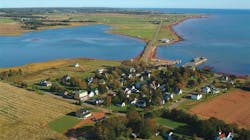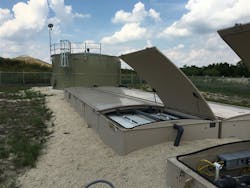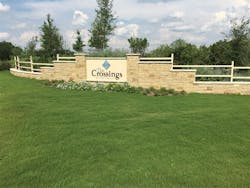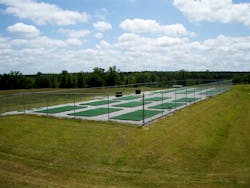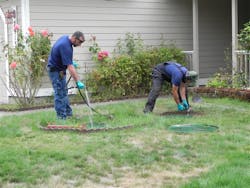Americans’ increased preference for living in small towns and rural areas is changing the map for utility planners. After three decades of wrestling with dwindling populations and revenue, small towns are reviving and receiving attention from developers and homebuyers.
Property demand in rural areas is more than just a temporary anomaly. Even before the pandemic, approximately four in 10 Americans said living in a rural area would be the ideal if they could. Three years later, some are finding that ideal becoming a real possibility. While higher mortgage rates have cooled the recent raging housing market, a handful of underlying factors are shifting the equation for continuing rural migration in fundamental ways.
The composition of rural migrant cohorts is also now trending younger than before. In addition to work-from-home policies, the rise of digital entrepreneurship is helping make that ideal rural lifestyle a viable option for those that are far from retirement. There is also demand across all age groups seeking more affordable rental housing, with more eyes looking beyond expensive metropolitan areas.
As Mark Smither of Paulsen Research remarked in an interview with American Equipment Manufacturers, “The idea [is] that where we live and where we work are now decoupled.”
Despite the prospects of a strengthening tax base, population inflection does not come without challenges, especially when that growth is likely to be lower density. Some states have hundreds of small communities without wastewater treatment systems that adequately protect environmental resources. Communities with decreasing or unpredictable tax revenue have deferred investment in traditional sewer solutions that would likely require unsustainable sewer rates for their citizens.
Though prudent from a financial standpoint, this has left growing communities without the resources necessary to support an increasing population.
Fringe growth and planned developments can cause real headaches for utility planners. Who pays for the new sewer line extensions: existing long-term customers or as-yet-theoretical new arrivals? Will major roads be clogged during sewer construction? How much more biological load can the treatment plant handle before the community has to say no to the next permit application?
While a gravity sewer was the solution traditionally taught in 20th-century engineering programs, solutions for wastewater collection have evolved to include more nimble options like liquid-only sewer and grinder systems, each considered a type of low-pressure sewer.
A grinder system macerates both solids and liquids into a slurry to be pumped downstream. In contrast, liquid-only sewer uses an on-lot tank, which collects solids to take advantage of passive digestion and sends only the liquid portion downstream through small-diameter (typically 1.5- to 2-inch) collection lines.
The slope requirements of gravity construction make avoiding existing utility lines difficult, not to mention the headache of any inadvertent damage and repair. Avoiding utility conflicts increases design time for gravity sewers, whereas pressure sewers can easily be rerouted. Laying small-diameter pipe in the roadside right-of-way via shallow trenching or even directional boring means streets will not be torn up, avoiding prolonged traffic delays and expensive pavement reconstruction.
Liquid-only sewer allows for maximum flexibility in siting: with only the liquid portion of the waste stream traveling through collection lines, neighboring communities can combine their liquid-only sewer systems and pump to a common treatment plant miles away. Or, because a liquid-only sewer contributes only minimal biochemical oxygen demand (BOD), a neighboring community’s existing wastewater treatment plant could accept the additional hydraulic load without worrying about biological overload.
In outlying areas where aquifer recharge is a particular concern, liquid-only sewer and decentralized treatment allow for keeping the treated effluent in the neighborhoods where it is generated. Treated effluent can be reused for surface irrigation, car washing, or dust control prior to discharge (subject to local regulations). This also negates the energy required to send recovered water long distances from a water treatment plant.
As a bonus, the low biological loading from a liquid-only sewer makes it possible to choose a passive treatment option like packed-bed filters. These systems use simple controls and do not require a full-time operator to continuously monitor or adjust the system, as would be needed in a traditional treatment facility. Rather, small towns can utilize a part-time operator who already serves in another capacity, such as road maintenance personnel, to do periodic inspections and light maintenance.
Completing a life-cycle cost analysis before making capital equipment investments is a critical step that utility planners literally cannot afford to skip. Equipment reliability, replacement rates, labor requirements for operation and maintenance, pump power costs, tank pumping intervals, mainline cleaning, air valve maintenance, and inflation scenarios all need to be factored into the equation. Before making a technology selection for their town, city officials should visit a comparable system — preferably one that has been in operation for at least 10 years — and ask about maintenance costs and hassles.
Life-cycle costs can differ widely by technology and by each local facility’s operational profile. A long-term (30- to 50-year), full life-cycle cost analysis can reshuffle the rank of suitable solutions. This timeframe is long enough to get a sense of equipment failure intervals, and any reputable manufacturer should be able to provide inquirers with this information.
Utility planners often find themselves in the middle of town council discussions around controlled growth and expansion of city limits. A town’s autonomy to make decisions based on the needs and desires of the community, rather than just on affordability, is no small benefit to planners. If growth is desired, planners can extend a liquid-only sewer main to specific peripheral zones or require a developer to install a liquid-only sewer with its own neighborhood treatment plant. Liquid-only sewer is appropriate for both medium and low-density communities, as would commonly be found in rural America.
Once upon a time, rural areas’ economies were somewhat insulated from the economic fluctuations happening in metropolitan areas. With continued rural migration, economic connections are changing. Utility planners can be ready for whatever curveball is thrown next by taking advantage of flexible wastewater approaches, ultimately maintaining a clean environment and serving their rural communities.
